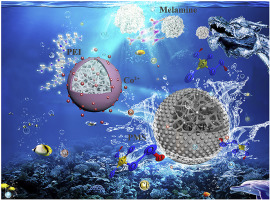Journal of Cleaner Production ( IF 9.7 ) Pub Date : 2019-07-17 , DOI: 10.1016/j.jclepro.2019.117630 Shufeng Bo , Junmei Luo , Qingda An , Xin Zhao , Zuoyi Xiao , Shangru Zhai , Zhongcheng Li

|
Resource recovery and environmental remediation serve to meet the scientific and technical challenges of cost-effective and sustainable strategy, especially for circular utilization of valuable metal and treatment of various wastewater (toxic metal ions, organics, etc.). Encouragingly, the research on circular utilization of recovered valuable metals in peroxymonosulfate (PMS) activation for pollutants degradation is currently in blank; herein, a multistage utilization process for preparing Co/N-doped carbonaceous catalyst is plausibly proposed for the first time. Namely, by using a cheap and abundant alginate as a self-generating 3D network precursor, the interior/exterior modified aerogel beads (denoted as Ca–Me/[email protected]) are fabricated via a simple sol-gel assembly for toxic metals removal or valuable metals recovery, following that Co2+ adsorbed composite (denoted as Ca–Me/[email protected]) are converted into Co/N-doped carbonaceous catalyst (denoted as [email protected]) by carbonization. Increased surface chelating sites and polarity with abundant functional components (N = 15.68%) bring strong affinity to metal ions via ion-exchange, complexation and electrostatic interactions. Detailed isotherms, kinetics and dynamic studies illuminate the high adsorption capacity (698.62 mg/g), fast adsorption rate and long-term operation stability of Ca–Me/[email protected] adsorbent toward Co2+, respectively. Of particular interest of is that, the catalyst evolved from Co2+ adsorbed composite exhibits relatively-superior catalytic ability towards utilizing PMS oxidant to degrade organic pollutants. Animatingly, the simulation of real water system makes it potential for the multistage utilization of composites in actual industrial wastewater treatment. The coupling of watermelon-like structure and Co/N co-doping endows the adsorptive catalyst sustainable utilization capacity in heterogeneous catalysis based on the concept of “utilizing waste treating waste” circular economy, avoiding the problem of insufficient stability of ion adsorbed aerogel catalyst in PMS homogeneous catalysis.
中文翻译:

循环利用Co(II)吸附的复合材料转化为Co / N掺杂的碳质催化剂可有效降解有机污染物
资源回收和环境修复有助于应对具有成本效益和可持续发展战略的科学和技术挑战,特别是在循环利用贵重金属和处理各种废水(有毒金属离子,有机物等)方面。)。令人鼓舞的是,有关过氧单硫酸盐(PMS)活化中回收的有价金属循环利用以降解污染物的研究目前处于空白状态。在本文中,首次提出了一种用于制备Co / N掺杂的碳质催化剂的多阶段利用方法。即,通过使用廉价且丰富的藻酸盐作为自生成的3D网络前体,通过简单的溶胶-凝胶组件制备了内部/外部改性气凝胶珠(表示为Ca–Me / [电子邮件保护]),以去除有毒金属或随后的Co 2+回收或有价值的金属吸附的复合材料(表示为Ca–Me / [受电子邮件保护])通过碳化转化为Co / N掺杂的碳质催化剂(表示为[受电子邮件保护])。具有丰富功能成分(N = 15.68%)的增加的表面螯合位点和极性,通过离子交换,络合和静电相互作用,对金属离子具有很强的亲和力。详细的等温线,动力学和动力学研究分别阐明了Ca-Me / [受电子邮件保护的]吸附剂对Co 2+的高吸附容量(698.62 mg / g),快速吸附速率和长期运行稳定性。特别令人感兴趣的是,催化剂是从Co 2+演变而来的吸附的复合材料在利用PMS氧化剂降解有机污染物方面表现出相对较高的催化能力。在动画上,真实水系统的仿真使其有潜力在实际工业废水处理中对复合材料进行多级利用。西瓜状结构与Co / N共掺杂的耦合赋予吸附催化剂在“利用废物处理废物”循环经济概念下的非均相催化可持续利用能力,避免了离子吸附气凝胶催化剂稳定性不足的问题。 PMS均相催化。









































 京公网安备 11010802027423号
京公网安备 11010802027423号